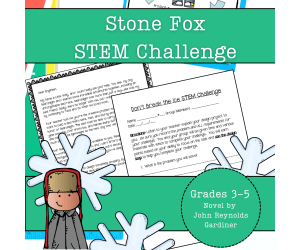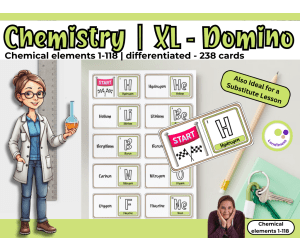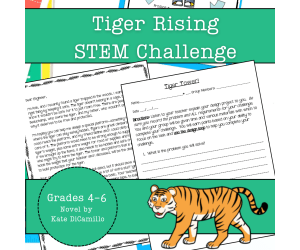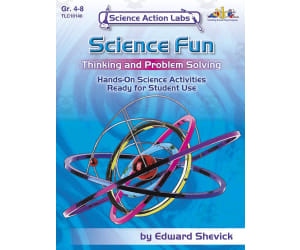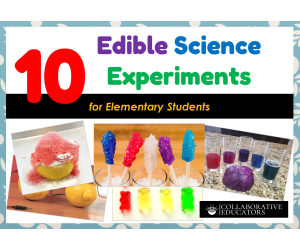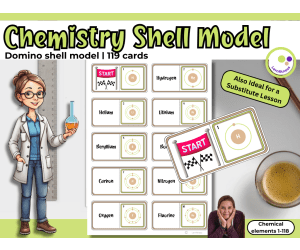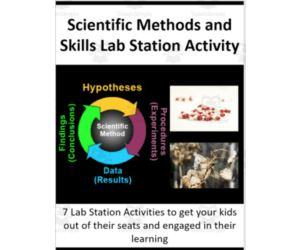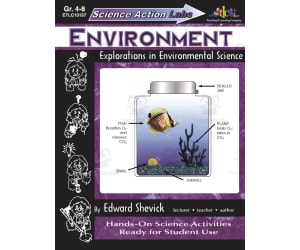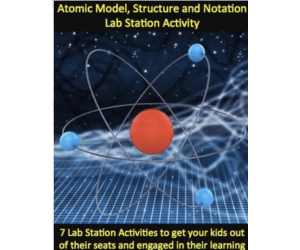2,757 products added recently
Holiday and Seasonal Experiments
Combine the joy of holidays with the wonder of science through seasonal experiments. This collection offers activities aligned with various celebrations, such as creating crystal ornaments, exploring thermal reactions on winter days, or making colorful eggs for spring. By integrating these holiday experiments into your classroom, you can make learning festive and fun.
Stone Fox STEM Experiment + STEM Project for Grades 3, 4, 5
Science, Technology, Engineering, STEM, Grade 3, 4, 5, Experiments, Activities, Projects, Diagrams, Teacher Tools, Graphic Organizers, Rubrics
Little Willy is looking for a way to build a sled that will honor Searchlight, in this STEM project inspired by Stone Fox. This science project encourages problem-solving as students plan and construct a sled that will be able to carry Willy safely across a block of ice. Perfect for blending literature with science, it allows students to explore engineering concepts using simple supplies while promoting teamwork and critical thinking. What’s Inside This Resource: Student Letter: A heartfelt letter from Little Willy introduces the challenge, linking the story to a real-world engineering task. Design Loop Graphic: A visual students can attach to their science journals, serving as a step-by-step guide throughout the activity. Detailed Instructions: Choose to print the guide as a packet or have students record each stage in their journals for an interactive experience. Teacher Tips: Practical guidance for crafting a clear problem statement with time constraints, materials, and success criteria tailored to your classroom. Skills Your Students Will Build: ✔ Problem-Solving: Identify obstacles and create inventive solutions. ✔ Engineering Design: Navigate the design loop—plan, construct, test, and refine. This page can easily be enlarged for a classroom poster. ✔ Critical Thinking: Assess their prototype’s performance and pinpoint ways to enhance it. ✔ Teamwork: Collaborate effectively to accomplish shared goals. Versatile Classroom Application: Whether as guided instruction or part of an integrated literature and science unit, this STEM science project encourages students to think creatively, document their process, and meet science and engineering standards. The rubric included is based on engineering concepts, but can also be used as a nonfiction writing rubric for cross-curricular options. Why Educators Love This Resource: ⭐ “My students were fully engaged, combining their passion for reading with STEM!” ⭐ “Simple to set up and encourages creativity and teamwork.” ⭐ “A seamless connection between literature and science for cross-curricular learning!” Encourage your students to help Little Willy achieve his goals and experience the excitement of engineering with this standards-aligned STEM adventure!
Author Kel's Klass
Tags 4th Grade Science Project, 4th Grade Science Experiment, 5th Grade Science Project, 5th Grade Science Experiment, Engineering Diagram, Science Graphic Organizer, Science Rubric, 3rd Grade Science Project, 3rd Grade Science Experiment, Stone Fox
Chemistry Binder Covers – Templates for Classroom Use
Life Sciences, Science, STEM, Inventors, Basic Science, Chemistry, Special Resources, Montessori, Classroom Management, Resources for Teachers, Homeschool Templates, Grade 7, 8, 9, 10, 11, 12, Worksheets, Worksheets & Printables, Teacher Tools, Projects, Activities, Workbooks, Drawing Templates & Outlines, Templates, Graphic Organizers, Experiments
Chemistry Binder Covers – Templates for Classroom Use Organize your chemistry handouts, notes, and units with visual clarity Simple and flexible templates to help organize your chemistry materials In my chemistry classes, it can be a challenge to keep things organized - especially when it comes to multiple units, lab notes, worksheets and review materials. To make it easier for my students and myself, I designed these simple binder sleeves. There are 12 different pages. The covers have a clean, colorful blob layout that is friendly but not distracting. I usually print them out and use them as cover sheets or as dividers in folders for students or teachers. They also work well for digital learning environments, e.g. as section covers in PDF files or on classroom platforms. I like that the color scheme allows students to quickly find what they are looking for, and it brings a little more structure to a subject that is often riddled with formulas and technical terms. When used as cover sheets, students can choose their favorite color for their cover sheet. This resource is handy - and has saved me a lot of time in lesson preparation and follow-up. What’s included: 12 chemistry-themed cover pages different colors zu choose as a cover sheet as a divider between the individual chemistry topics I've printed these on colored paper for my own binder and also used them digitally in student notebooks. Works well for both teacher organization and student-facing materials. 📍 Best wishes, Heike from Lernfitness Chemistry teacher (Biology teacher, Math teacher) in Germany Did You Know? I teach with a certified therapy dog, and together we create a positive and inspiring learning environment. 🐶✨
Author Lernfitness
Rating
Tags Science, STEM, Chemistry, Binder, Template, Cover Sheet, Organizer, Organize, GoodNotes, PDF
10 Plant Experiments for Elementary School
Nature & Plants, Life Sciences, Science, Grade 3, 4, 5, Labs, Experiments, Activities
These ten easy and entertaining plant experiments make science come to life. Students test the effects of soil, water, and light on plant growth in small groups. They observe how plants bend toward light, watch seeds grow, and watch celery drink colored water. Easy-to-find supplies and precise, detailed instructions are used in each experiment. The lesson teaches practical science skills like forecasting, observing, and documenting data while fostering curiosity and teamwork. Students can ponder, write, and reflect on what they observe with the help of the associated worksheet. To keep every student interested and involved, teachers can set up alternating experiment stations. The worksheet concludes with the answers. Although it can be modified for younger or older students, this curriculum is ideal for Grades 4-5. It links classroom instruction to nature and promotes experiential learning. This ready-to-use, low-prep lesson will add interest to your science class and allow your children to experiment, discover, and develop a love of plants!
Author Bright Classroom Ideas Marketplace
Rating
Tags Plant, Experiment, Lab, Biology, Botany, Elementary, Grade 4, Grade 5
XL Domino – Chemical Elements 1–118 | exploring element names + symbol
STEM, Science, Chemistry, Physics, Life Sciences, Montessori, Basic Science, Grade 7, 8, 9, 10, 11, 12, Activities, Games, Worksheets & Printables, Task Cards, Quizzes and Tests, Teacher Tools, Word Problems, Flashcards, Escape Room, Experiments
XL Domino – Chemical Elements 1–118 An interactive domino game for exploring element names and symbols 🧪🎲 This printable XL domino game offers a fun and flexible way for students to practice the names and symbols of all 118 chemical elements. Designed for use in grades 7–10, this resource supports both introductory lessons and ongoing review in chemistry class. Whether used in small groups, as a full-class activity, or even spread out along the hallway floor, it encourages active learning and collaboration. Each card features either the name or the symbol of a chemical element. By matching these correctly, students build a long domino chain – all while reinforcing their knowledge of atomic numbers, symbols, and the layout of the periodic table. What’s included: 238 printable domino cards (PDF format) Two complete versions of the game (119 cards each): – Beginner version: element names on both sides – Advanced version: name on one side, symbol on the other Covers all elements from hydrogen (1) to oganesson (118) Tips for setup and gameplay included How I’ve used it: This game works well before introducing the periodic table in depth. It gives students time to get comfortable with element names and symbols in a low-pressure setting. The larger card format makes it ideal for group work or movement-based activities, such as arranging the cards on the floor or in the hallway. Why it works: The visual repetition and active gameplay help students internalize key facts more effectively than passive memorization. Group dynamics also support peer learning – students naturally help each other recall unfamiliar elements. And because it feels like a game, students stay engaged longer and show more willingness to participate. The material is easy to prepare: print, laminate if you like, and cut out the cards. From there, you can adapt it for differentiated learning levels or turn it into a competitive classroom challenge. This is not just a game – it’s a versatile teaching tool that brings the periodic table to life. 📍 Best wishes, Heike from @Lernfitness Did You Know? I teach with a certified therapy dog, and together we create a positive and welcoming learning environment. 🐶
Author Lernfitness
Rating
Tags Educational Card Games, Chemistry, Physics, STEM Science Matching Game, Chemical Elements, Periodic Table Matching Game, Game, Domino, Differentiation
Science Activities For Your PreK Classroom
, Preschool, Grade 1, 2, Activities, Experiments
You’re never too young to learn about Science! Includes these fun, easy-to-do craft projects : Giant Bubbles, Windy Day Fun, and Sink or Float?
Author Twin Sisters Digital Media
Tags Crafts, Science, Experiment, Activity, Classroom
Let's Investigate! Hands-On Science - Grades 1-2
, Grade 1, 2, Activities, Experiments, Teacher Tools, Lesson Plans
Let's Investigate! Hands-On Science - Grades 1-2 Let's Investigate! Hands-On Science - Grades 1-2 is a complete teaching aid packed with brain teasing activities aimed to introduce students to the mesmerizing world of science. Covering three main areas of science: physical, earth, and life sciences. A Comprehensive Teaching Toolbox This guide is designed as a comprehensive teaching toolbox filled with actionable activities geared towards fostering independent learning among students. Each activity encompasses an easy-to-follow set of instructions ensuring direct comprehension and engagement. These tasks are not merely focused on rote learning but also encourage observation skills and foster critical thinking development through guided questions. Beyond just Activities Rather than just presenting fun activities, this guide includes interesting facts throughout its contents adding another layer of enrichment to students' learning journey. Extension activities are also added providing more avenues for knowledge exploration beyond classroom discussions. List: Fascinating Science Facts Extension Activities An Activity Guide About the Activity Guide: The Activity Guide located towards the end offers useful background information along with tips that can be leveraged by educators to ensure an enjoyable yet valuable scientific exploration experience for their classes. Note:The Let's Investigate! Hands-On Science - Grades 1-2 package comes as a single PDF made up of 64 pages prepared in advance waiting to be printed whenever you need them – maximizing accessibility without sacrificing time-efficiency. Whether for whole-class instruction or small group teachings or even homework assignments – this highly adaptable tool Line by Teach Simple aims at empowering Grade 1 & Grade 2 learners in their curious journey into the realm of Science. Get started today, grab your digital copies and experience how physical sciences, earth sciences, or life science concepts can become incredibly tangible learning experiences for your students.
Author Classroom Complete Press
Tags Let's Investigate, Hands-on Science, Science Experiments, Fossil Fun, Underwater Test
Tiger Rising STEM Experiment + STEM Project for Grades 4, 5, 6
Science, Technology, Engineering, STEM, Grade 4, 5, 6, Experiments, Activities, Projects, Diagrams, Teacher Tools, Graphic Organizers, Rubrics
This hands-on activity combines creativity and problem-solving as students design and build a tower for the safety of the tiger in the novel, Tiger Rising. Perfect for integrating literature and science, this challenge encourages students to apply engineering principles using simple materials while fostering teamwork and critical thinking. What’s Inside This Resource: Student Letter: A letter from Rob Horton introduces the challenge, linking the story to a real-world engineering task. Design Loop Graphic: A visual students can attach to their science journals, serving as a step-by-step guide throughout the activity. Detailed Instructions: Choose to print the guide as a packet or have students record each stage in their journals for an interactive experience. Teacher Tips: Practical guidance for crafting a clear problem statement with time constraints, materials, and success criteria tailored to your classroom. Skills Your Students Will Build: ✔ Problem-Solving: Identify obstacles and create inventive solutions. ✔ Engineering Design: Navigate the design loop—plan, construct, test, and refine. This page can easily be enlarged for a classroom poster. ✔ Critical Thinking: Assess their prototype’s performance and pinpoint ways to enhance it. ✔ Teamwork: Collaborate effectively to accomplish shared goals. Versatile Classroom Application: Whether as guided instruction or part of an integrated literature and science unit, this STEM activity encourages students to think creatively, document their process, and meet science and engineering standards. The rubric included is based on engineering concepts, but can also be used as a nonfiction writing rubric for cross-curricular options. Why Educators Love This Resource: ⭐ “My students were fully engaged, combining their passion for reading with STEM!” ⭐ “Simple to set up and encourages creativity and teamwork.” ⭐ “A seamless connection between literature and science for cross-curricular learning!” Encourage your students to provide a safe haven for the tiger (and Rob and Sistine?) and experience the excitement of engineering with this standards-aligned STEM adventure!
Author Kel's Klass
Tags 4th Grade Science Project, 4th Grade Science Experiment, 5th Grade Science Project, 5th Grade Science Experiment, 6th Grade Science Project, 6th Grade Science Experiment, Engineering Diagram, Science Graphic Organizer, Science Rubric, Tiger Rising
Number the Stars STEM Experiment + STEM Project for Grades 4, 5, 6
Science, Technology, Engineering, STEM, Grade 4, 5, 6, Experiments, Activities, Projects, Diagrams, Teacher Tools, Graphic Organizers, Rubrics
This hands-on activity combines creativity and problem-solving as students design and build a basket for Anne Marie to get the package safely to Uncle Henrik, based on the novel Number the Stars! Perfect for integrating literature and science, this challenge encourages students to apply engineering principles using simple materials while fostering teamwork and critical thinking. What’s Inside This Resource: Student Letter: A letter from Anne Marie introduces the challenge, linking the story to a real-world engineering task. Design Loop Graphic: A visual students can attach to their science journals, serving as a step-by-step guide throughout the activity. Detailed Instructions: Choose to print the guide as a packet or have students record each stage in their journals for an interactive experience. Teacher Tips: Practical guidance for crafting a clear problem statement with time constraints, materials, and success criteria tailored to your classroom. Skills Your Students Will Build: ✔ Problem-Solving: Identify obstacles and create inventive solutions. ✔ Engineering Design: Navigate the design loop—plan, construct, test, and refine. This page can easily be enlarged for a classroom poster. ✔ Critical Thinking: Assess their prototype’s performance and pinpoint ways to enhance it. ✔ Teamwork: Collaborate effectively to accomplish shared goals. Versatile Classroom Application: Whether as guided instruction or part of an integrated literature and science unit, this STEM activity encourages students to think creatively, document their process, and meet science and engineering standards. The rubric included is based on engineering concepts, but can also be used as a nonfiction writing rubric for cross-curricular options. Why Educators Love This Resource: ⭐ “My students were fully engaged, combining their passion for reading with STEM!” ⭐ “Simple to set up and encourages creativity and teamwork.” ⭐ “A seamless connection between literature and science for cross-curricular learning!” Empower your students to solve Anne Marie's immediate need and experience the excitement of engineering with this standards-aligned STEM adventure!
Author Kel's Klass
Tags 4th Grade Science Project, 4th Grade Science Experiment, 5th Grade Science Project, 5th Grade Science Experiment, 6th Grade Science Project, 6th Grade Science Experiment, Engineering Diagram, Science Graphic Organizer, Science Rubric, Bridge To Terabithia
Biology Binder Covers – Templates for Classroom Use
Life Sciences, Science, STEM, Basic Science, Special Resources, Montessori, Classroom Management, Resources for Teachers, Biology, Human Body, Homeschool Templates, Grade 7, 8, 9, 10, 11, 12, Worksheets, Worksheets & Printables, Teacher Tools, Projects, Activities, Workbooks, Drawing Templates & Outlines, Templates, Graphic Organizers, Experiments
Biology Binder Covers – Templates for Classroom Use Organize your biology handouts, notes, and units with visual clarity Simple and flexible templates to help organize your biology materials In my biology classes, it can be a challenge to keep things organized - especially when it comes to multiple units, lab notes, worksheets and review materials. To make it easier for my students and myself, I designed these simple binder sleeves. There are 12 different pages. The covers have a clean, colorful blob layout that is friendly but not distracting. I usually print them out and use them as cover sheets or as dividers in folders for students or teachers. They also work well for digital learning environments, e.g. as section covers in PDF files or on classroom platforms. I like that the color scheme allows students to quickly find what they are looking for, and it brings a little more structure to a subject that is often riddled with formulas and technical terms. When used as cover sheets, students can choose their favorite color for their cover sheet. This resource is handy - and has saved me a lot of time in lesson preparation and follow-up. What’s included: 12 biology-themed cover pages different colors zu choose as a cover sheet as a divider between the individual biology topics I've printed these on colored paper for my own binder and also used them digitally in student notebooks. Works well for both teacher organization and student-facing materials. 📍 Best wishes, Heike from Lernfitness Biology teacher (Chemistry teacher, Math teacher) in Germany Did You Know? I teach with a certified therapy dog, and together we create a positive and inspiring learning environment. 🐶✨
Author Lernfitness
Rating
Tags Science, Biology, STEM, Binder, Cover Sheet, Template, Organizer, Organize, GoodNotes, PDF
Free Science Chemical Reaction Interactive Vocabulary Review Activity
Science, Basic Science, Life Sciences, Biology, Chemistry, Grade 7, Activities, Experiments, Teacher Tools, Lesson Plans
Free Science Chemical Reaction Vocabulary Review for Grade 7 This interactive PowerPoint teaches and reviews key vocabulary words related to chemical reactions in grade 7 science. It covers concepts like characteristics and the importance of chemical reactions. The presentation features a multiple choice review activity to assess understanding. Students select a letter and the answer is revealed. If incorrect, the answer is marked with an X until the right selection is made. The activity is visual, interactive, and engaging for whole group or independent practice. It's perfect for remote learning. After reviewing the 29 slides, students will have learned and reinforced seventh grade science vocabulary on chemical reactions. The activity is part of a series from ShapeUp-N-Matematicas y Lenguaje focused on middle grades science and Spanish language arts.
Author ShapeUp-N-Matematicas y Lenguaje
Tags Chemical Reaction, Periodic Table, Chemical Structure, Boiling Point, Freezing Point, Endothermic Reaction, Exothermic Reaction, Small Or Whole Group, Interactive Activity, Games
Creative Science Activities for Active Learners
, Grade 5, 6, 7, 8, Activities, Experiments
Creative Science Activities for Active Learners: An Engaging Teaching Tool The Creative Science Activities for Active Learners resource is a high-energy tool kits that enhances your students' scientific knowledge. This resource offers over 50 exciting activities, each of which can be completed within 15 minutes. Designed to be versatile and flexible, it serves as an engaging kickstart to classroom discussions, homework tasks, or extra credit assignments. These quick but meaningful engagements perfectly fill the short moments between class schedules and standard lessons. A Comprehensive Scientific Learning Resource This resource primarily aims at enhancing and reinforcing students' comprehension of key scientific concepts. It presents topics from Life Science, Environmental Science, Earth/Space Science all in a fun way that appeals to active learners in grades 5-8. Evasion Tasks with Extra Challenges and Problem Solving Components All activities come with Extra Challenges and problem-solving aspects appealing to young curious minds. Key issues covered include pollution management, understanding space fragments phenomena or how parasites operate within their hosts. Creative science activities employment can lead to innovative thinking among pupils as they explore science's many wonders at their own pace! Your Acquisition Includes: A downloadable PDF file comprising of 128 ready-to-print pages made up of scientifically enriching adventures focused on experiments - neatly divided into bite-sized tasks for easy absorption without overwhelming the young scholars. The Creative Science Activities for Active Learners teaching tool is essential whether you're catering to a entire class, addressing small group settings or even providing guided homeschooling. This interactive learning experience will pave the way towards creative scientific discoveries.
Author Classroom Complete Press
Tags Creative Science, Science Experiments, Science Activities, Space Science, Life Science
Science Action Labs Science Fun: Activities to Encourage Students to Think and Solve Problems
Literature, Grade 4, 5, 6, 7, 8, Labs, Experiments, Activities
Science Action Labs Science Fun: Activities to Encourage Students to Think and Solve Problems This amazing resource is a practical teaching tool designed for educators, both in traditional classroom settings and homeschool environments. Geared towards students from Grades 4 up to Grade 8, this comprehensive collection of science labs aims at making learning more engaging. Overview: Diverse suite of activities for exploring scientific principles. Ranging from experiments like Spinning Science, Gravity Sci-Fun, Building a Better Boomerang to Static Electricity experiments . Boosts curiosity & encourages problem-solving through real-world applications. The unique lab activities equipped with supporting literature can really help in enhancing subject understanding by creating perfect balance between theory and practice. Bonuses: Fosters higher-order thinking skills Promotes active participation Makes learning process immersive & fun-focused The Offering: In a downloadable PDF format with 64 ready-to-print pages - just download, print, distribute! Versatile usage; from individual worksheets for reinforcement or review purposes or structured as part of group classes where discussion becomes part of the learning process. This offering truly brings flexibility right into your classroom or home! In Summary: If you're looking at enriching science materials aimed at promoting conceptual understanding over rote memorization - look no further than 'Science Action Labs Science Fun: Activities to Encourage Students To Think And Solve Problems'. A worthy addition indeed!
Author Classroom Complete Press
Tags Fun Activities, Science Labs, Reverse Technology, Gravity Science Fun, Problem Solving
10 Edible Science Experiments for Elementary Students
Chemistry, Science, Grade 1, 2, 3, 4, 5, Labs, Experiments, Activities
Prepare yourselves for some incredibly entertaining science! "Edible Science Experiments for Elementary Explorers," this book, is your pass to a delicious journey. Do you wish to witness a rainbow that is (almost) edible? We have it. Consider creating enormous gummy bears. Simple as pie. You can even produce real butter and shake cream. That's cool, isn't it? There are ten incredible experiments within. You can find items in your kitchen for each one. The steps are quite easy. We give you detailed instructions. And you know what? The majority of the outcomes are yours to keep! You'll learn cool stuff too. Like why some liquids float and others sink. Or how mixing things can make bubbles. Science doesn't have to be boring. This book proves it! So grab your grown-up, put on your apron, and let's get started. You'll be a science whiz in no time. And you'll have some tasty treats along the way. It's science you can taste! Let the edible experiments begin!
Author Bright Classroom Ideas Marketplace
Rating
Tags Science, Chemistry, Lab, Elementary, Experiment
Photosynthesis Lesson and Experiment for 3rd and 4th Grade Science
Science, Nature & Plants, Life Sciences, Earth and Environmental Sciences, Earth Sciences, Grade 3, 4, 5, Centers, Activities, Labs, Experiments, Worksheets, Worksheets & Printables
Photosynthesis Lesson, Worksheets, and Experiment How Plants Make Food - 3rd & 4th Grade Science Lesson I created this resource to give students a clear and enjoyable introduction to photosynthesis. The lesson blends reading, discussion, and a hands-on experiment so students can see how plants make their own food in a way that feels real and meaningful. I put this resource together because photosynthesis is one of those topics that becomes much easier to understand when students can read about it and observe it in action. This set offers a mix of activities that help students explore the idea from different angles. What’s inside? A short reading passage that explains photosynthesis Seven comprehension questions with an answer key A step by step experiment using black gram seeds Follow-up discussion questions to guide class conversation Safety notes and cautions for the experiment Two anchor charts that break the process into small pieces A quick True/False activity with answers A diagram activity where students label the photosynthesis process A story-writing page where students write from the point of view of a plant Complete answer keys to all the questions are included in this resource Resource features: I designed this set with 3rd and 4th graders in my mind. The reading level and activities are approachable for that age group. The experiment inside the resource is simple enough for students to complete in small groups, but still gives them something meaningful to observe. I have written all the instructions clearly. Each activity in this resource builds on the previous one so students can connect ideas as they go. This resource also blends science with literacy, drawing, and creative thinking, which makes it easy to fit into a variety of lesson plans or science centers. Ways to use it: Reading activity: Have students read the passage and answer the questions independently or with partners. Vocabulary work: Create a small word wall or glossary for science terms. Hands-on learning: Set up the seed experiment as a class or rotate it through small groups. Science journals: Encourage students to record their predictions and observations throughout the experiment. Art activity: Students can draw and label the parts of a plant involved in photosynthesis. Writing prompt: Let students write a short story from the perspective of a plant creating its own food. Group talk: Compare observations, discuss results, and talk through what might have caused them. Extensions: Students can look at different types of plants and explore how sunlight and environment affect their growth. Usefulness for teachers, homeschoolers, and parents This resource works well as a mini-unit as it requires very little preparation. The activities give students different ways to understand the process of photosynthesis. This resource is suitable for a wide range of learners. It supports reading comprehension, science vocabulary, and basic scientific inquiry skills, all while keeping instructions simple enough for independent use. The experiment uses easy to find materials, and the activities make it simple to incorporate science into home learning or family projects. photosynthesis, 3rd grade science, 4th grade science, anecdotal activity, photosynthesis story, hands-on learning, plant science, reading comprehension, science experiments, STEM, elementary education, homeschool science, nature study, scientific inquiry, vocabulary building, cross-curricular learning, environmental education, chlorophyll experiment, plant growth, science journaling, critical thinking, observation skills, teaching resource, environmental science, anchor charts, photosynthesis experiment
Author FlashKart
Rating
Tags Science, Photosynthesis, Plants, 3rd Grade Science, 4th Grade Science, Photosynthesis Experiment, Science Reading, Sunlight, Science Process, Earth Science
Atomic Shell Model Domino – Learning Electron Configurations Play
STEM, Science, Chemistry, Physics, Life Sciences, Montessori, Basic Science, Grade 7, 8, 9, 10, 11, 12, Activities, Games, Worksheets & Printables, Task Cards, Quizzes and Tests, Teacher Tools, Word Problems, Flashcards, Escape Room, Experiments
Atomic Shell Model Domino – Learning Electron Configurations Through Play 118 cards for learning the periodic table A classroom game to practice atomic structure and element knowledge 🧪🎲 This printable domino game helps students explore the shell model of the atom while getting to know the periodic table in a more hands-on and interactive way. Each card connects an element name to a visual of its electron shell configuration, offering a playful way to reinforce key chemistry concepts. The set includes 119 domino-style cards – covering all 118 known elements. On each card, the element name is on the left and the corresponding shell diagram with its symbol is on the right. Students link them by matching the shell model of one element to the name of the next. It’s a surprisingly effective way to help them recognize patterns in atomic structure, get familiar with chemical symbols, and connect abstract content to something more tangible. What’s included: 119 printable domino cards (PDF) Each card shows: element name → electron shell model with element symbol Print-ready format; laminating optional but recommended Classroom ideas: Use as a full-class activity or in small groups Introduce the game before formal work with the periodic table to build foundational understanding Great for movement-based tasks: spread the cards across tables or even down a hallway Set time challenges: Who can build the longest correct domino chain? For easier levels, use a reduced set (e.g., first 20 elements or just the main groups) In my chemistry classes, students enjoy the game format – especially those who don’t usually connect with abstract models. Working together to build the correct sequence gives them a chance to talk through the structure of atoms and test their understanding in a low-pressure setting. The domino format encourages active learning, peer interaction, and multiple ways to differentiate by level. Whether you use the full set or simplify it for younger learners, it’s a great way to bring more movement and discussion into your science lessons. Just print, cut, and you’re ready to play. 📍 Best wishes, Heike from @Lernfitness Did You Know? I teach with a certified therapy dog, and together we create a positive and welcoming learning environment. 🐶
Author Lernfitness
Rating
Tags Educational Card Games, Chemistry, Physics, STEM Science Matching Game, Chemical Elements, Periodic Table Matching Game, Shell Model, Game, Domino
Cancer Volume II – Lab Station Activity
Science, Life Sciences, Biology, Grade 7, 8, 9, 10, 11, Labs, Experiments, Activities
The Carbon and Water Cycle – Lab Station Activity This is an engaging teaching resource exclusively designed for educators and homeschoolers. It offers a highly interactive, customizable lab station activity exploring the carbon and water cycles. Main Features: Hands-on learning material with proven effectiveness in student engagement Caters to various learning styles. No extensive preparation required. Simply download, print out the cards and place them around your classroom or create virtual stations for online learners. Each station comes with a detailed description card providing instructions or guiding questions for active discussion among students. Station Activities Include: Offering opinions Answering questions based on videos or readings . Drawing exercises Bonus activities such as word scrambles or word searches are included to ensure productive use of time between transitions from one station to another. These can be integrated into grading system or used as optional enrichment tasks. 'Rest Stations' allow students to catch up on any unfinished assignments without feeling rushed when transiting from one station to another. 'Real-world Topic Stations' provide short readings linking classroom material directly with practical applications in today's world. Exercise modes vary across stations: From tapping into creative skills at one station, researching surrounding topics using own devices at other stations, reading related passages, writing down opinions etc., each provides a unique student experience. A Comprehensive Learning Solution: The Lab Station Activity is focused on key Science/Biology study topics for Grades 7 through 11 specifically carbon cycle and water cycle. Furthermore, it can be adjusted smoothly across different classroom settings – whole class activities, small collaborative groups or individual homework assignments. In Summary: The Carbon and Water Cycle Lab Station Activity provides a highly dynamic and student-preferred learning environment, bridging seamlessly across various teaching styles.
Author Teach With Fergy
Tags Carbon Cycle, Water Cycle, Lab Activity, Hands-on Learning, Interactive
Let's Investigate! Hands-On Science - Grades 5-6
, Grade 5, 6, Activities, Experiments, Teacher Tools, Lesson Plans
Let's Investigate! Hands-On Science - Grades 5-6 Let's Investigate! Hands-On Science - Grades 5-6 takes students on a thrilling journey of scientific discovery. It offers educators an effective tool for stimulating curiosity and encouraging independent learning in the fields of physical science, earth science, and life science.The particular emphasis is on experiential learning made possible through engaging activities. About This Teaching Resource This teaching resource contains 64 pages filled with mind-stretching activities designed to foster exploration into the fascinating world of science. It presents an ideal blend of fun, simplicity, and education that makes even complex concepts easily digestible for fifth or sixth-grade students. The Activities: Easy yet Engaging! The interesting activities contained within this resource require minimal preparation time from educators yet yield maximum student engagement. Each assignment provides clear step-by-step instructions to allow for seamless classroom execution. Whether implemented in a whole group setting or smaller clusters, these hands-on experiments will stimulate young minds at varying levels of comprehension. Critical Thinking Skills: Let's Investigate! Hands-On Science studies significantly focus on developing critical thinking skills espeially needed in scientific explorations. Puzzling Questions: Guided questions accompanying each activity serve as pivotal challenges that cultivate the art of observation and reasoning among pupils. Facts Reinforcement: Captivating snippets of facts scattered throughout the book reinforce students' understanding while feeding their natural curiosity. "Extension Activities": They lend further depth to their knowledge by prompting exploration beyond what's covered in class discussions. Extra Teacher Resources Included! To help educators navigate effortlessly through each experiment and secure better results with every endeavor at teaching scientifically-geared topics, this resource includes two invaluable assets: a comprehensive background information section and an insightful Activity Guide. Each aid is carefully crafted to provide teachers with data-rich content about relevant subject matter as well as beneficial tips to utilize exactly how you wish during lessons or even for homework assignments! In a Nutshell Available in handy PDF format ready-to-print format, Let's Investigate! Hands-On Science - Grades 5-6 stands as a versatile addition to any curriculum intended for fifth to sixth-grade science instruction. Whether you are a public school teacher or you educate at home, this resource ensures an enriching hands-on learning experience steeped in elements of fun, understanding and scientific wonder.
Author Classroom Complete Press
Tags Air Pressure Experiment , Tornado In A Bottle, Let's Investigate, Hands-on Science, Earth Science Experiments
Scientific Method and Science Skills – Lab Station Activity
, Grade 7, 8, 9, 10, Labs, Experiments, Activities
Lab Station Activities: The Scientific Method and Science Skills Engage students in learning science skills and the scientific method with this hands-on lab station activity . Students rotate through 9 stations, each offering a unique way to apply and practice concepts like using the scientific method, identifying variables, drawing inferences, analyzing data, and more. The carefully designed stations allow students to get out of their seats while learning. Activities include drawing models, conducting research, writing explanations, answering test questions, learning from video clips, and even creating their own questions. Helpful station cards provide instructions and guidance for students at each station. To complement the hands-on stations, the activity also includes a word scramble and word search for students to work on, ensuring they stay engaged during any transition times. An answer key is provided for applicable stations and activities. This versatile resource can be used as an introductory or review lab activity for the scientific method and science skills. It requires almost no prep-work for teachers - simply print and distribute the station cards and students are ready to learn by doing. This activity keeps students engaged through assessment-based learning stations, promoting retention and deeper understanding. Use it to teach or review topics like: - The scientific method - Scientific theories - Making observations and inferences - Identifying independent and dependent variables - Understanding gravity, motion, and other key concepts Other Lab Station Activities: The product creator offers a wide variety of lab station activities for science topics including biology, chemistry, physics, ecology, space science, and more. Search [insert teacher name] to find hands-on activities on cell theory, ecosystems, chemical reactions, electricity, the solar system, and much more.
Author Teach With Fergy
Tags Scientific, Method, Theory, Variables, Lab Station, Scientific Method Lab Activity
Energy Flow In Ecosystems – Lab Station Activity
Science, Life Sciences, Biology, Grade 8, 9, 10, Labs, Experiments, Activities
Energy Flow In Ecosystems Lab Station Activity Students get hands-on with the flow of energy through ecosystems in this engaging lab station activity. As they rotate through 9 stations, learners strengthen their understanding of topics like photosynthesis, cellular respiration, food chains and webs, ecological pyramids, and more. The activity covers producers, consumers, herbivores, carnivores and omnivores while connecting concepts to real-world applications. With a variety of learning modes including drawing, research, assessment , reading passages, and video, the stations offer something for all types of learners. The activity comes with station description cards, student recording sheets, word scrambles and searches to prevent downtime, and answer keys for the teacher. This versatile resource works for whole group, small group, or independent learning structures.
Author Teach With Fergy
Tags Scavenger, Food Chain, Energy, Flow, Ecosystems
Science Action Labs Environment: Explorations in Environmental Science
Science, Earth and Environmental Sciences, Environmental Science, Grade 4, 5, 6, 7, 8, Labs, Experiments, Activities
Science Action Labs Environment: Explorations in Environmental Science This comprehensive teaching resource is designed to bring science to life for Grade 4 to 8 students. The toolkit offers an interesting adventure into environmental science, provoking students to engage deeply with various scientific problems. Main Features: The resource primarily focuses on different scientific mysteries which can be applied in a variety of classroom settings. It can be used as part of whole-group instruction, in small study groups or even assigned as homework, opening doors for differentiated learning. Gives both teachers and students the freedom to experiment with a wide array of scientific concepts without feeling overwhelmed. Provides ample opportunities for promoting active learning through hands-on experience. Molding Young Minds: Students are encouraged to use their thinking abilities and problem-solving skills vastly while navigating through these intriguing scientific puzzles. It triggers interest about environmental science subjects via engaging labs thereby fostering deeper understanding amongst the youngsters. Syllabus Compatibility and Approachability: The toolkit contains 64 ready-to-print PDF pages packed with practical content making it align perfectly with core Environmental Science syllabus common at primary schools. Additionally, the easy-to-comprehend language used throughout this resource accommodates varying reading abilities present within those grades. Educational Impact This tool truly simplifies intricate ideas and facilitates children approach them at their own pace under guided supervision from educators. By integrating this aid into lesson planning - educators could considerably boost classroom discussions around logical reasoning all while effectively sparking intellectual growth among budding learners over time.' Lasting Influence: Habitual usage of this dynamic resource not only amplifies student engagement but also succeeds to instill critical-thinking skills crucial in developmental years leading up towards higher education—making education substantial and nourishing at every step.
Author Classroom Complete Press
Tags Environmental, Science, Action Labs, Explorations, Science Activity
Atomic Model, Structure and Notation – Lab Station Activity
Science, Chemistry, Grade 7, 8, 9, 10, Labs, Experiments, Activities
Atomic Model, Structure and Notation Lab Station Activity Engage students in learning atomic model, structure, and notation through this customizable lab station activity . Students move through various stations testing their knowledge about topics like atomic theory history, the Bohr-Rutherford atomic model, subatomic particles, calculating atomic mass/numbers, and more. Activities include drawing models, researching questions, writing explanations, watching videos, answering test questions, and even formulating their own questions. Recording sheets provided for students to document their work. Use this as an introductory or review lab activity in individual, small group, or whole class settings to bring interactive chemistry learning to life. Modifiable with answer keys. 7th-10th grade. Chemistry.
Author Teach With Fergy
Tags Atomic, Model, Structure, Notation, Lab Station, Simple Atomic Model
Liquids and Gases – Lab Station Activity
Science, Physics, Grade 6, 7, 8, 9, Labs, Experiments, Activities
Liquids and Gases – Lab Station Activity is a valuable educational resource designed to enhance classroom learning for middle and high school students, especially those studying physical science. This affirmative lab activity engages students with an in-depth examination of Earth's biomes, promoting student movement and interaction. What sets this comprehensive resource apart is its coverage of critical topics like: Biome Types, Aquatic areas, Grasslands, Forests, Deserts, Tundra, etc., Beyond passive learning, different stations offer tasks that engage students actively, teaching them through the process of doing. The task may range from"drawing", or"constructing at one station", to developing their own comprehension testing queries at another. The way these stations function: Drawing or Construction tasks which require creativity. Involves research where children can look into pre-set questions about relevant subjects using either classroom computers or personal devices. , Inclusion of writing activities where participants express their formulated opinions cohesively in paragraphs form. . To counterbalance workload: We've got rest stations designed for reviewing prior content or preparing for future sections. More so there are real-life-based activity sections that lean into reading articles. Testing: The curriculum is reinforced with multiple-choice quizzes. Media-based Learning: Includes video content with corresponding questionnaires to further grasp comprehension level. Create your own Quiz Station: This exciting station allows students to both answer pre-set quiz questions and devise their student quizzes by creating multiple choice true/false queries alongside short response questions! For an elevated learning experience, word scramble and word search games have been cleverly interposed between activities; this sustains learner engagement and eradicates classroom monotony. Finally, Liquids and Gases – Lab Station Activity accounts for teachers' convenience too! Without requiring any elaborate preparations or setup hassles, even fully ready to print when needed! With its interactive nature, this lab activity could be easily incorporated into whole group studies, small group explorations, pair work or given as homework assignments. This makes it is versatile enough useful whether you're a public school teacher looking to provide engaging instruction or a homeschooler seeking varied resources.
Author Teach With Fergy
Tags Liquids, Gases, Lab Activity, Ecosystems, Hands-on Learning
Cells and The Cell Theory – Lab Station Activity
Science, Life Sciences, Biology, Grade 7, 8, 9, 10, Labs, Experiments, Activities
Cells and The Cell Theory – Engaging Lab Station Activity Bring cells and cell theory to life for your middle or high school science students with this interactive lab station activity . Students will rotate through 9 stations, each offering a unique hands-on opportunity to build their understanding of cells, organelles, cell types, diseases, and more. Activities range from drawing cells to answering questions based on videos and readings to creating their own quiz questions. Almost no prep needed - just print the self-contained station cards and guides. Bonus word scramble and word search activities ensure students stay engaged. This versatile resource works for both learning new content or reviewing before a test. With 9 lively stations packed with visual, written and creative interactions, your students will love discovering cells and cell theory!
Author Teach With Fergy
Tags Cells, Plant, Animal, Cell Theory, Lab Station, Cell Structure Lab, Cell Theory For Middle School
Refraction – Lab Station Activity
Science, Physics, Grade 7, 8, 9, 10, Labs, Experiments, Activities
Refraction – Lab Station Activity is a physics teaching resource for educators to engage students in hands-on learning. Through nine interactive stations, students explore key concepts like apparent depth, index of refraction, and more. Activities range from creative drawing prompts and videos to answering knowledge checks and writing explanations. This self-directed 30-45 minute lab gives students exposure to real-world examples while providing built-in support materials like reading passages, answer keys, word games, and recording sheets to keep students focused. Teachers can implement whole-class, but sessions also work for small groups or independent practice. This multifaceted refraction lab is one module in a physics series exploring concepts like motion, energy, light, sound, and flight through inquiry-based activities customizable for grades 7-10.
Author Teach With Fergy
Tags Refraction, Speed, Light, Physics, Lab Station, Refraction Of Light Lab


